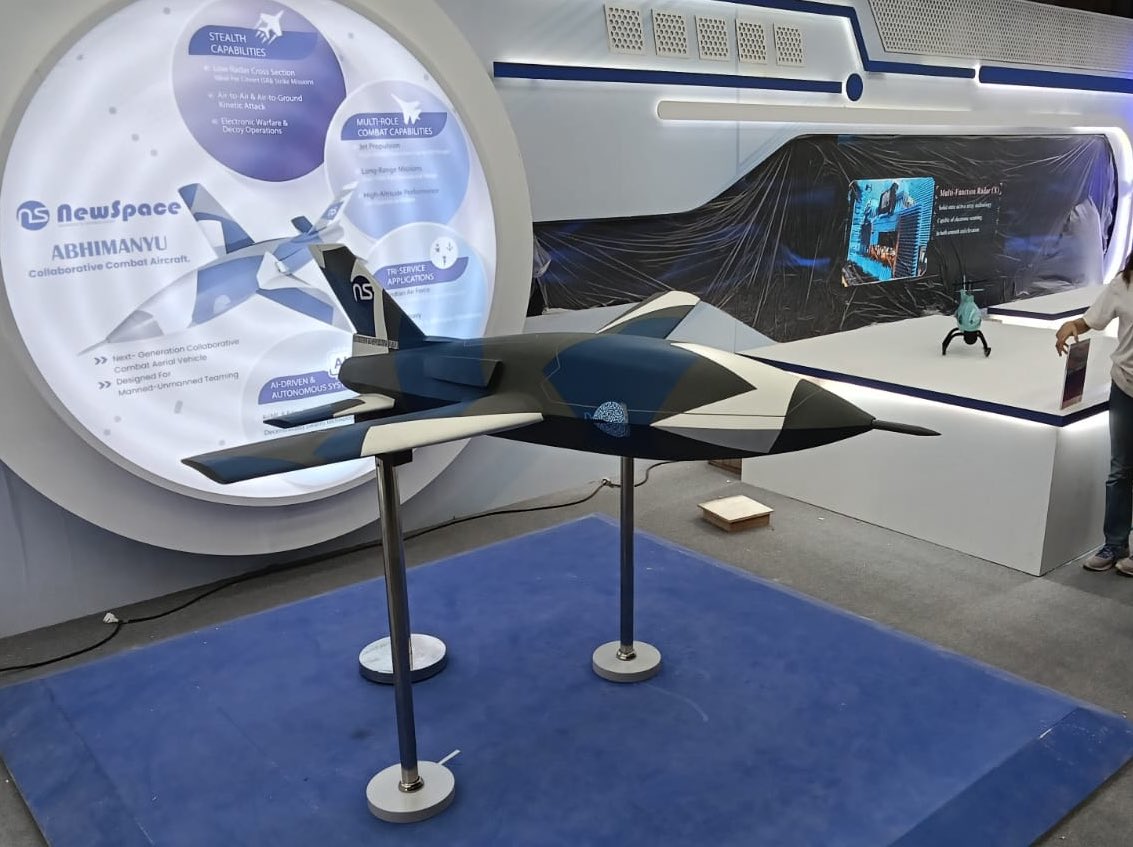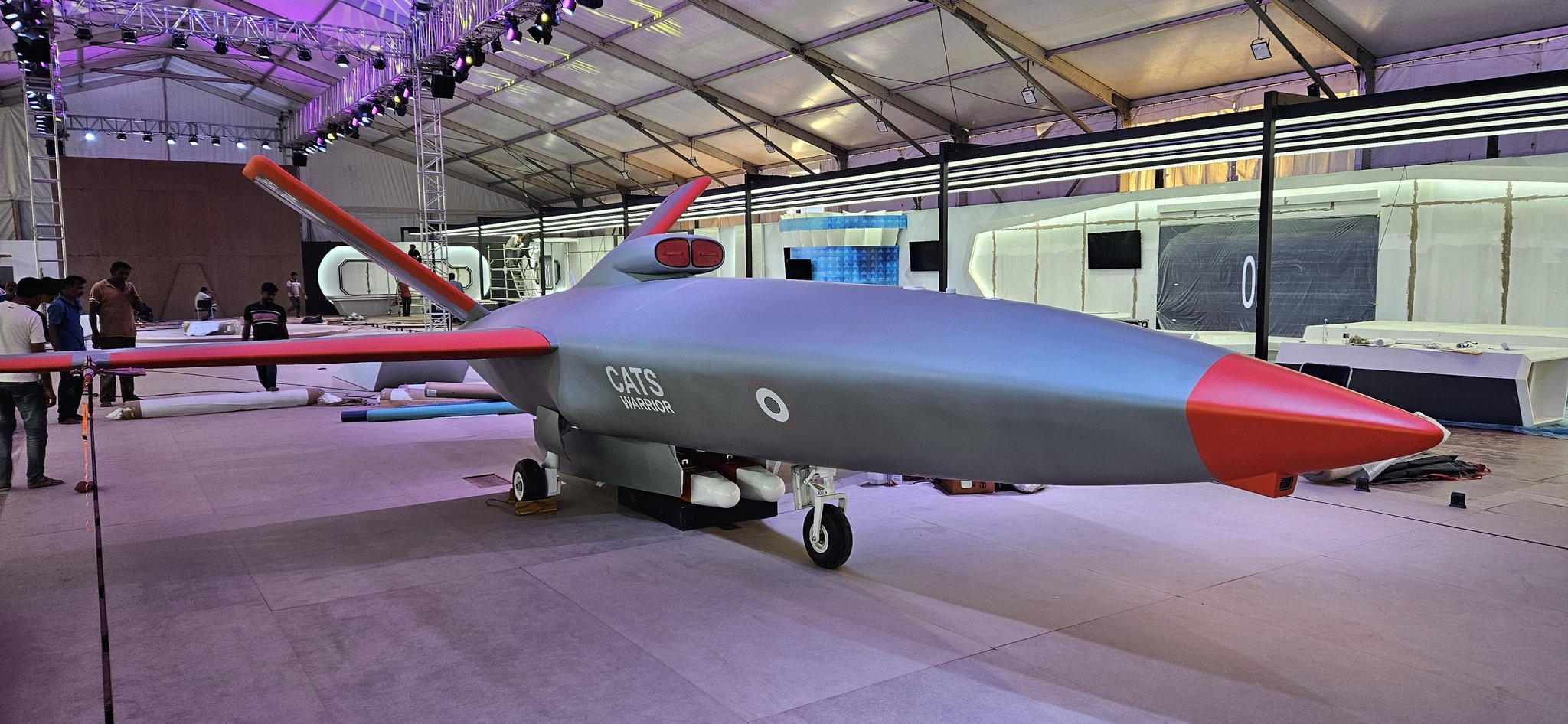The Indian Navy has set into motion the development of a loyal wingman drone that will fly in manned-unmanned teaming (MUMT) with its fighter jets. Interestingly, the development comes as the timeline for the induction of the Indian Navy’s indigenous carrier-based aircraft has been pushed further away.
The Indian Navy has shortlisted a Bengaluru-based startup firm, NewSpace Research and Technologies (NRT), to develop a future Naval Collaborative Combat Air Vehicle (N-CCAV).
The drone will be based on an existing collaborative combat aircraft (loyal wingman) design, Abhimanyu, which is a jet-powered, low-observable design developed by NRT.
The term “Loyal Wingman” is a novel concept in military aviation wherein unmanned combat aerial vehicles (UCAVs) or autonomous or semi-autonomous drones work in tandem with piloted aircraft to carry out various combat and support tasks.
These drones act as “wingmen” to human pilots, providing increased situational awareness, expanding mission capabilities, and reducing the risk to human pilots by taking on more dangerous or complex tasks. The Abhimanyu CCA, for instance, is designed for carrying out Intelligence, Surveillance, and Reconnaissance (ISR) missions, kinetic kills, and electronic warfare (EW) missions, among other things.
As per the plan, the futuristic N-CCAV will work in a manned-unmanned teaming configuration with Indian Navy fighter jets, including the existing carrier-based MiG-29K fighters, the Rafale-M for which a deal is likely to be signed shortly, and other planned domestic naval aircraft.
While information about the deal is scant, the report claimed that the Indian Navy has committed to purchase an unknown number of N-CCAV platforms once the construction is complete. The work on the N-CCAV has commenced.

A model of Abhimanyu was displayed at the ongoing Aero India 2025. The CCA appears to have a single vertical tail, horizontal stabilizers, and swept wings.
Additionally, the drone’s single jet engine has two small air intakes, one on each side of the rear fuselage. The infographic placard displayed along with the CCA describes the aircraft as a long-range, high-speed, swarm-capable multirole aircraft. It has a range of about 1,000 kilometers, an endurance of about 20 hours, and an operational speed of about 550 kilometers/hour.
The manufacturer states that the aircraft enables “collaboration for manned-unmanned teaming to create an effective kill-mesh.” Additionally, the Abhimanyu has an electro-optic/ infrared camera for ISR missions and a warhead for air-to-air and air-to-ground kinetic attack missions.
With a variety of capabilities, Abhimanyu drones might provide India’s carrier air wings with significant additional offensive and defensive capability when used in conjunction with other crewed aircraft. The pilotless aircraft may also improve situational awareness and tactical flexibility by increasing a carrier strike group’s sensor reach.
Moreover, with this, India will position itself as one of the few countries that are diligent in advancing work on loyal wingman drones.
In addition to Abhimanyu, a futuristic unmanned wingman drone meant for the Indian Air Force (IAF)—the Combat Air Teaming System (CATS) Warrior—has also been displayed at the Aero Show 2025 by Hindustan Aeronautics Limited. This drone will operate alongside manned fighters like the LCA Tejas.

Notably, while a locally developed loyal wingman drone is in the works for the Indian Navy, its indigenously developed carrier-based aircraft remains a distant reality. Currently, the only carrier-capable aircraft in the Indian Navy’s inventory is the MiG-29K.
Though the service is progressing toward acquiring 26 Rafale-Marine aircraft, the HAL Twin Engine Deck-Based Fighter (TEDBF) is not expected to join the force anytime soon.
So, if and when the naval loyal wingman drone is delivered, it will work in a MUMT format with the MiG-29K, which remains riddled with problems and a small number of Rafale Marines. The indigenously developed loyal wingman drone will likely not operate with an indigenous fighter jet for a long time.
A representative from NRT told EurAsian Times Sr. Editor – Ritu Sharma: “Abhimanyu is still in the concept stage. We were chosen by the Indian Navy just a couple of days ago. We will be negotiating nitty gritties. The contract will be signed in a few months.
12 months after the signing of the contract, a scaled prototype will be delivered. The final prototype will be delivered after 30 months. And final delivery will be after 36 months.
The aircraft is required to fly from the deck of an aircraft carrier or warship. Initially, it will be a catapult launch, and in the future, it will be a cargo box launch”.
TEDBF Far From Induction
The Indian Navy’s proposed futuristic stealthy carrier-based fighter—the TEDBF—has been displayed at the Aero India 2025 show. It is a twin-engine, medium-weight, Short Take-off But Arrested Recovery (STOBAR) aircraft with a Delta-Canard wing. It has been optimized for carrier operations and performance in air defense and maritime strike roles.
The aircraft, according to its manufacturer HAL, will be compatible with both INS Vikramaditya and INS Vikrant aircraft carriers. Additionally, it will be equipped with a wing-folding mechanism and integrated with refueling pods to play a tanker role, as specified in the placard displayed along with the TEDBF model.
The Aeronautical Development Agency (ADA), a consortium of laboratories that spearheads all of India’s crewed fighter programs, released an updated timeline for planned indigenous aircraft. As per the projections, the delivery of the TEDBF will commence in 2038, more than a decade from now.

The aircraft is expected to replace the MiG-29K, which will remain in service until then.
The MiG-29K is a Soviet-era aircraft tailored for carrier operations and has run into several serious issues, including engine malfunction and poor operational capability. Reports in 2023 stated that the Indian Navy was unsure that the MiG-29K fleet would survive into 2030 because of defects, inconsistencies, and anomalies in the airframe that will make flying them increasingly dangerous.
While the TEDBF remains elusive for another decade, another indigenously developed aircraft for the Indian Navy–the LCA Tejas-naval variant– does not currently figure in discussions regarding its possible induction in the Navy. The aircraft has also been displayed at the Aero India 2025 along with the MiG-29K and helicopters operated by the Navy’s aviation arm.
The chief of the Defence Research and Development Organisation (DRDO) was earlier known to be pushing for the Indian Navy to buy the naval variant of LCA as the organization works on the Twin Engine Deck Based Fighter (TEDBF), as previously reported by the EurAsian Times.
However, the service reluctantly stated that it wants the TEDBF project to take off in full flow before taking the final call on LCA-Navy. It is likely that the Indian Navy might induct the N-CCAV before it inducts an indigenously developed carrier-based aircraft.
- Contact the author at sakshi.tiwari9555 (at) gmail.com
- Follow EurAsian Times on Google News




